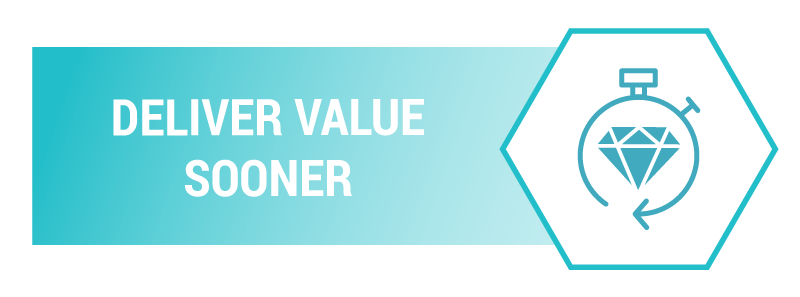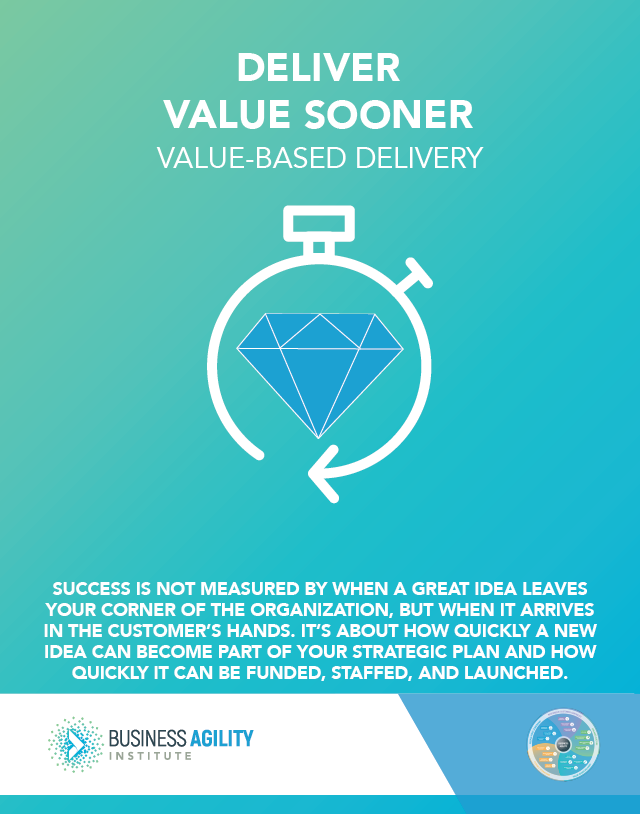Domains of Business Agility
- Responsive Customer-Centricity
- / Fiercely Champion The Customer
- / Sense & Respond Proactively
- / Integrate Diverse Ideas
- Engaged Culture
- / Cultivate A “Learning Organization”
- / Engage Transparently & Courageously
- / Embed Psychological Safety
- / Act As One
- Value-Based Delivery
- / Unleash Workflow Creatively
- / Prioritize. Prioritize. Prioritize.
- / Deliver Value Sooner
- / Seize Emergent Opportunities
- Flexible Operations
- / Adapt Strategies Seamlessly
- / Fund Work Dynamically
- / (Re)Organize Structures Fluidly
- / Balance Governance And Risk
- People-First Leadership
- / Foster Authentic Relationships
- / Empower With Accountability
- / Realize People’s Potential
How quickly can a great idea move through your organization into the hands of your customers? The promise of agility is more value delivered more quickly — and the trick is seeing the whole picture. It’s about how quickly a new idea can become part of your strategic plan and how quickly it can be funded, staffed, and launched. As ideas become reality, it’s crucial for them to be able to move through various parts of your organization at lightning speed.
Success is not measured by when a great idea leaves your corner of the organization, but by when it arrives in the customer’s hands. A crucial question is, therefore, how frequently your customer wants something new. A common misconception is that agility always works to decrease time to market. In reality, agile businesses are able to dance between immediate needs and longer-term needs. The goal is to deliver the right value at the right time for the customer.
Primary Behaviors
The following 4 behaviors strongly contribute to the ability to deliver value sooner.
B44: Everyone breaks down and delivers work from the perspective of a customer: Plans are created by breaking down large pieces of work into smaller pieces of work. Each smaller piece of work is outcome-based and represents a piece of value that could be delivered to the customer.
B45: Leaders create stable cross-functional teams: Leaders foster high performance by staffing teams with the variety of skills, functional knowledge, and experience needed to do their work. As much as possible, leaders keep team members together long enough so that the team moves from being a working group to being a true team.
B46: Leaders set clear direction and measures of success: One of the most impactful skills of a leader is to set clear expectations without succumbing to micro-management. By setting the right context for the people of the organization, leaders are able to create a vision-aligned and purpose-driven organization.
B47: Leaders enable new employees to be effective quickly by focusing onboarding on organizational networks, interactions, culture, and values, in addition to the necessary processes & tools: An employee’s first days with a new company are not just spent getting them setup with the processes, tools, and information needed to do their immediate job. Leaders also spend time with new employees to share the “big picture” of the organization’s mission, culture and values so that they understand the context and motivation underlying their position and work.


